“They returned… but stay I did”: Doreen Canaday’s Experience of Interwar Greece
Posted: October 3, 2018 Filed under: Archaeology, Archival Research, Biography, Book Reviews, Classics, History of Archaeology, Philhellenism, Women's Studies | Tags: Doreen Canaday Spitzer, Mariam Coffin Canaday, Ward Canaday 1 CommentI first encountered the name “Canaday” in the mid-1980s when I went to Bryn Mawr College for graduate school. Although we did most of our work in the seminar rooms above the Art and Archaeology Library (now the Rhys Carpenter Library), for books and periodicals about history or classics we had to go to the “big library,” which was none other than the Mariam Coffin Canaday Library.
A few years later when I returned to Greece to participate in the regular program of the American School of Classical Studies at Athens (ASCSA, or the School hereafter), I heard people referring to Canaday House. One of the two marble houses flanking the Gennadius Library at 61 Souidias, it housed temporarily the family of the then Director of the School William (Willy) D. E. Coulson. (The big earthquake of 1986 in Kalamata had caused damages to the Director’s residence across the street.)
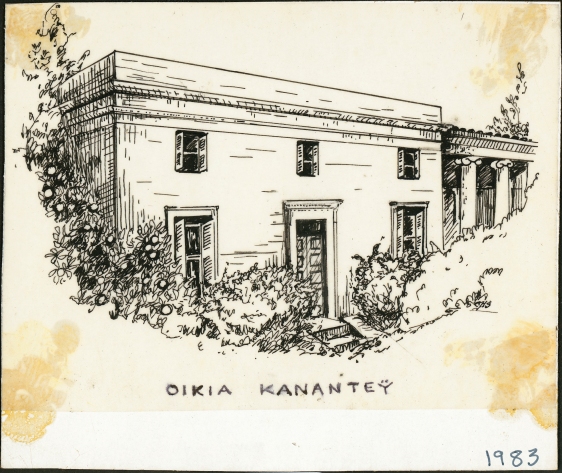
An ink drawing of the Canaday House at the American School of Classical Studies at Athens. ASCSA Archives, Doreen Canaday Spitzer Photographic Collection.
Finally, in the summer of 1990, while digging at Mochlos on Crete, I met Doreen Spitzer on one of the “On-Site with The American School of Classical Studies at Athens” trips that she had been organizing for years, but without realizing that Doreen Spitzer’s maiden name was Canaday. It was only after I started working as the School’s Archivist that I became aware of Canaday Spitzer’s long legacy at the American School. Doreen Canaday Spitzer (1914-2010) served as a Trustee 1978-1996, President of the Board of Trustees 1983-1988, Trustee Emerita from 1996 and President of the Friends from 1988 until her death in 2010. (There is a thorough biographical essay about Doreen Spitzer by Catherine de Grazia Vanderpool in AKOUE 63, Fall 2010.) Her father, Ward Canaday (1885-1976), had also served as a Trustee of the School for almost four decades starting in 1937.
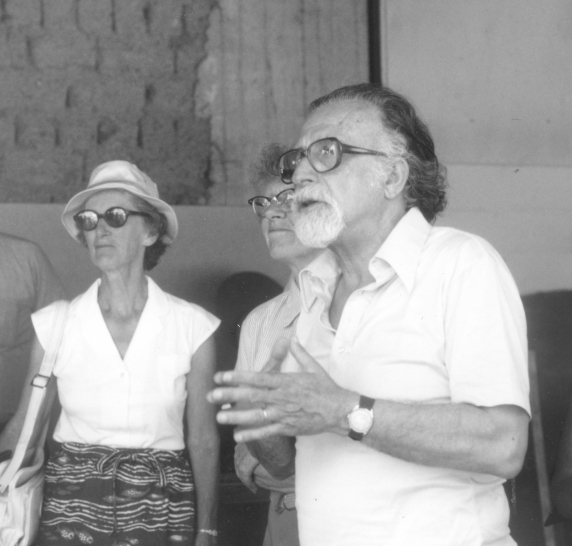
Doreen Canaday Spitzer listening to Manolis Andronikos, excavator of the royal tombs at Vergina, 1981. (Between them, barely visible, Machteld Mellink.) Source: ASCSA Archives.
Spitzer also cared deeply about preserving the School’s history and supported wholeheartedly the creation of an Archives Department during her term as President of the Board. Furthermore, she would contact School members, many of whom she knew personally from her time as a student of the School in 1936-1938, to solicit their personal papers. No wonder why my formal title is the Doreen Canaday Spitzer Archivist. Needless to say that it would have pleased her immensely to see our new and enlarged facilities at the East Wing of the Gennadius Library.
1933: The First of Many Visits
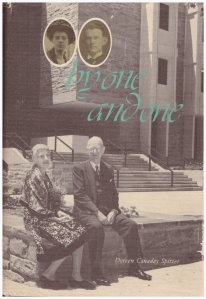
Doreen first visited Greece in 1933 at the end of her freshman year at Bryn Mawr College. “In the spring of 1933, in an expansive mood, he [Ward Canaday] brought home a briefcase, stuffed with exotic travel folders, for a change. His proposal, ‘How would you like to go on the Odyssey Cruise this summer?’ struck a responsive chord in wife and daughter,” related Doreen some fifty years later in her book By One and One (Canaan, NH 1984), a fascinating book she wrote about her parents. They sailed for Europe on the Berengaria with so many trunks that there was hardly any space for them in their first class cabin. As the single offspring of Ward Canaday and Mariam Coffin, she had been raised in an affluent household with all the comforts of an upper-class society girl. Mariam described Doreen as “Too self-conscious… and spoiled. Having whatever she wants is not good for her; she will never know the spur of necessity and her talent will never flower…” (p. 201). (In order to write By One and One, Doreen had access to her mother’s dairies.) She would change her opinion in the course of time as Doreen developed into a most caring person, raising a family of four and offering her time, organizational skills, and wealth to a number of institutions. In Doreen’s albums there are a few photos documenting the family’s first experience of Greece. One of them depicts the 19 year old Doreen on the Acropolis dressed in a light-colored fine dress with a pin-on corsage. Three years later she would adopt a more comfortable attire to meet the demand of the School’s strenuous travel program.
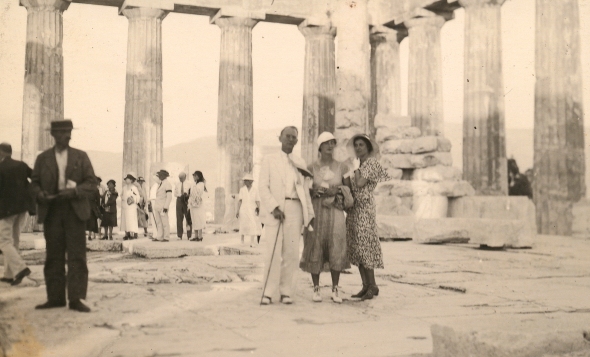
Odyssey Cruise 1933. Left to right: Ward Canaday and his daughter Doreen, and unidentified woman. ASCSA Archives, Doreen Canaday Spitzer Photographic Collection.
“The Odyssey Cruise turned out to be the first of many visits to Greece. Each of us made, from the experience, an enduring commitment to that country.” Her mother, an intelligent and romantic woman with a strong depth of feeling, was mesmerized by Greece; her father, a shrewd businessman, saw a lot of potential to expand his business to that country. On Crete, Mariam “managed to have five minutes alone on the throne of Minos, to feel the atmosphere” (p. 201). On Ithaca, home of Odysseus, she craved some privacy “but I couldn’t tell Ward I wanted to be alone, he would have not understood.” In 1933, Ward Canaday (1885-1976) was on his way to becoming one of America’s most important car manufacturers. After having set up his own advertising company in the 1920s with a rich clientele that included Willys Overland Motors –a Toledo, Ohio based company, Ward managed to raise funds and obtain Willys’ full control after the crash of 1929. By 1936 “the advertising man and his lawyer [George Ritter] were in charge of a large competitive motor car manufacturing business. And Ward Canaday was to remain in this role of automobile manufacturer for nearly two decades to come,” recalled Doreen in By One and One (pp. 184-185).
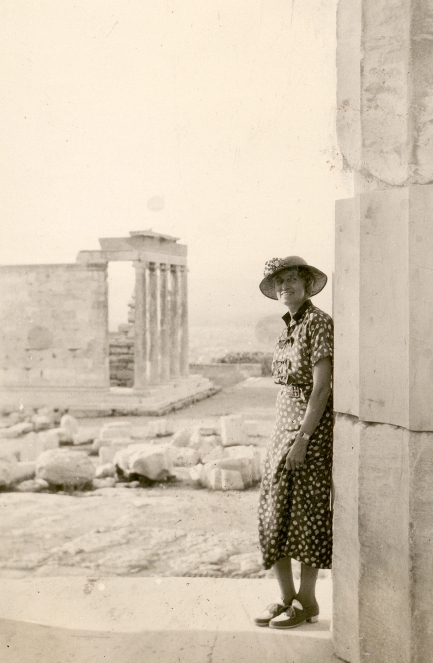
Mariam Coffin Canaday, Acropolis 1933. ASCSA Archives, Doreen Canaday Spitzer Photographic Collection.
1936-1938: Halcyon Days
By her senior year at Bryn Mawr Doreen had made up her mind to continue her studies at the American School of Classical Studies at Athens, despite objections from her father, who worried about political instability in the Balkan peninsula. Before doing so, and as a preparation for the School’s program, she decided to participate in the School’s summer session, an island cruise led by Louis E. Lord, Professor of Classics at Oberlin College. Mariam also joined Doreen in the cruise. “Aboard the venerable Greek steamer Epiros, sixty of us –including some of the most knowledgeable classical archaeologists of the day—visited all the major island sites. The knowledgeable archaeologists Doreen is referring to included the likes of Edith Hall Dohan, the excavator of Vrokastro on Crete, Mary Hamilton Swindler, professor of Classical archaeology at Bryn Mawr College, and Gisela Richter, curator of ancient art at the Metropolitan Museum.
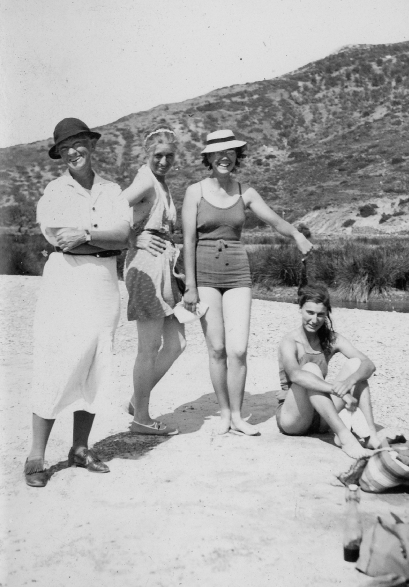
Swimming on the island of Skyros, 1936. Gisela Richter (?) first on the left, Doreen Canaday posing next to her. ASCSA Archives, Doreen Canaday Spitzer Photographic Collection.
True to Ward’s fears, that summer Greece was experiencing a prolonged period of political turmoil which culminated in a coup d’ etat on August 4th and the ensuing regime of General Ioannis Metaxas. Yet, it is unlikely that the country’s political uncertainty affected the daily life of the Americans who lived protected in the School’s compounds at the foot of Mt. Lycabettus. The list of members for 1936-37 counts forty men and women, the majority of whom were in their late 20s or early 30s, including the School’s new director, Charles H. Morgan, just 34 years of age. Doreen embraced the School’s vigorous program with passion and devotion as her letters to her family reveal (Vanderpool 2010). We may not have her letters in the ASCSA Archives but we are fortunate to have hundreds of snapshots from the two years she lived and travelled in Greece. (The Doreen Canaday Spitzer Photographic Collection was digitized in 2015-2016 with European Community funding and is available for online research.)
Doreen’s best friend in Athens in 1936-37 was Margaret (Miggy) Hill (later Whittman). There are several photos of them together. My favorite one depicts the two girls on mules ready to cross the Langada Pass on Mount Taygetus. Another one shows them in Old Corinth, after a day’s dig. They look like young boys in their baggy trousers and long-sleeved shirts; they also look happy. Doreen had come a long way since her first journey to Greece in 1933 when she travelled the country clad in fine dresses.
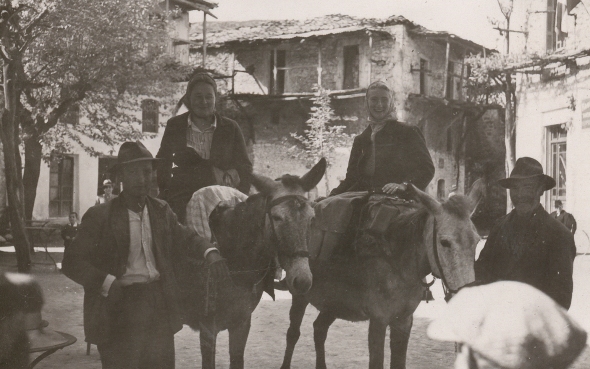
Margaret Hill and Doreen Canaday crossing Mt. Taygetus on mules, 1937. ASCSA Archives, Doreen Canaday Spitzer Photographic Collection.

Doreen Canaday and Margaret Hill, Corinth 1937. ASCSA Archives, Doreen Canaday Spitzer Photographic Collection.
When they were not travelling or digging, she and her friends played tennis in the School’s gardens, tried local food in the neighborhood, or took long rides to Glyfada.
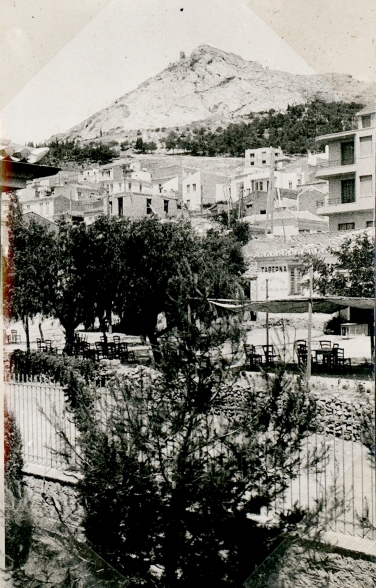
The predecessor of “L’Abreuvoir,” 1936-1937. It was owned by the family which runs now “Όμορφο.” ASCSA Archives, Doreen Canaday Spitzer Photographic Collection.
Doreen was the only student at the School who had her own car. How could she not, when your father owned an automobile company? In 1937, Willys Motors was marketing a new product: a small, trendy car at the unbelievable price of $395. “The ads featured its dramatic parrot nose and simple airflow lines, its peppy engine and maneuverable size. Sales were brisk. For promotional purposes one was sent to Ward’s daughter in Greece where it took to the hills and the rough roads with gusto” reminisced Doreen in her book (p. 185). Doreen would also not miss a chance to capture for her father examples of Willys automobiles running in Greece –buses in most cases.
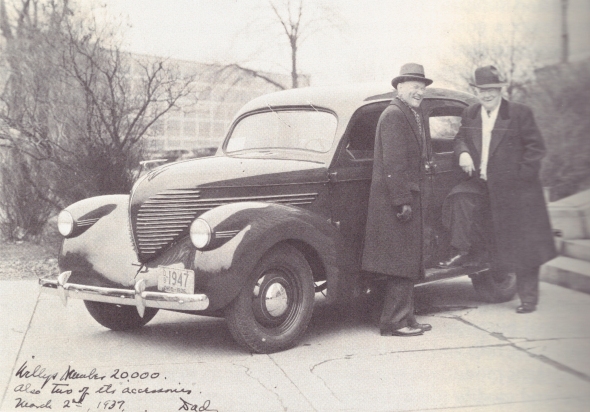
Ward Canaday (left) with his new model Willys, 1937. Source: By One and One, p. 186.
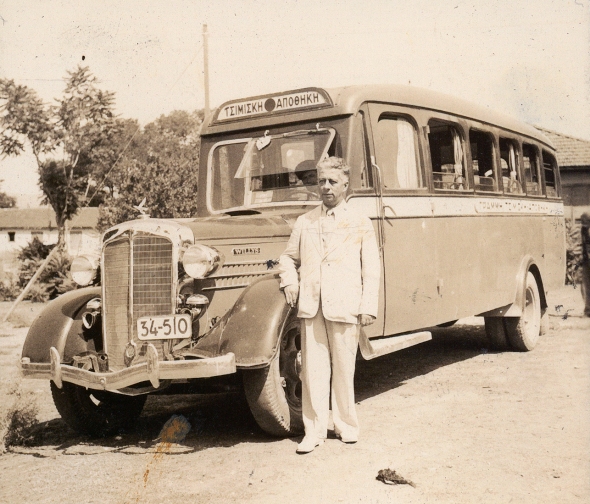
Willys bus (Τσιμισκή-Αποθήκη line), Thessaloniki, 1936-37. ASCSA Archives, Doreen Canaday Spitzer Photographic Collection.
I noted above that the School in the 1930s was a bustling place full of young people. There is a group photo in one of Doreen’s albums that captures the spirit of the School during that period. She has scribbled below the photo: “The Oxford Movement.” Although the group might have dubbed itself as such for its spiritual cohesion, I wonder whether this photo was not intentionally modeled after the Bloomsbury Group. (Kostis Kourellis was the first to write about the avand-garde spirit of the American archaeologists working in Greece in the 1930s; Hesperia 76:2, 2007, pp. 391-442.) Despite the different religious and social background of the people in the photo (e.g., Saul Weinberg was Jewish, Emily Grace a communist, who is not in this photo but was part of the group, and Doreen the daughter of an industrialist), I suspect that the binding agent in the School’s “Oxford Movement” was its desire for innovation.

The School’ s “Oxford Movement.” From left to right: Margaret Hill, Peggy MacVeagh, Mary Campbell, Dorothy Schierer, Bergen Gorpe (reclining), Elvis Starr, Saul Weinberg, Fred Householder, Doreen Canaday, Mr. Willoughby, Claude LaBreque, Francis C. Evans; Argolid 1937. ASCSA Archives, Doreen Canaday Spitzer Photographic Collection.
Doreen’s photos differ from those of Dorothy Burr Thompson. I have written elsewhere about the lyricism of Dorothy Burr’s photography and her love for the primitive. Dorothy, more than ten years older than Doreen, belonged to a generation that treated with suspicion the growing industrialism of America and looked for ways to escape it. Doreen, on the other hand, as the daughter of an industrialist, was the product of that environment. Her photography lacks lyricism; it is descriptive and factual. She was a skillful photographer, however. Her collection contains some great cityscapes which are worth showcasing in this presentation.
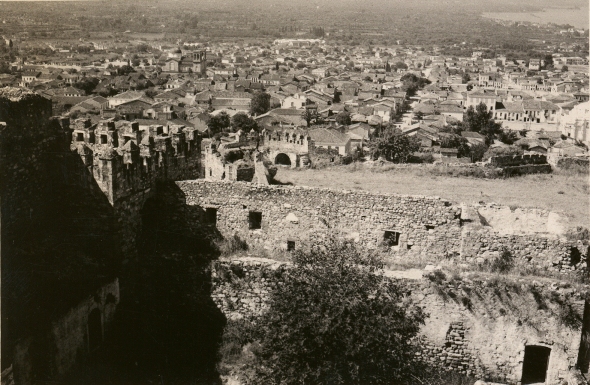
Patras, 1933 or 1936-37. ASCSA Archives, Doreen Canaday Spitzer Photographic Collection.
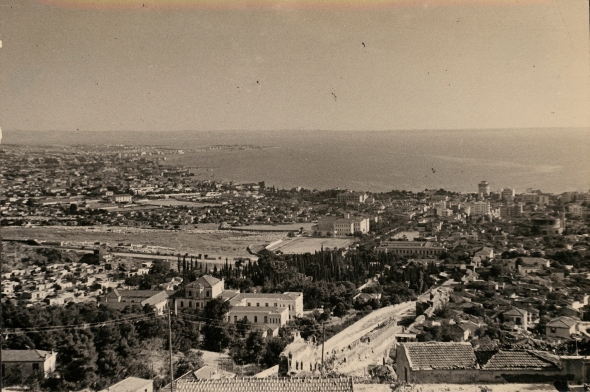
Thessaloniki 1933 or 1936-37. ASCSA Archives, Doreen Canaday Spitzer
Occasionally she attempted some indoor photography, which was difficult before the 1960s requiring extra skills and equipment. Snapshots from interiors of houses or museums are rare in the ASCSA photographic collections. Therefore, the few that do exist have high informational value. Here is one of the interior of the old museum in Olympia (Don’t miss the little reconstruction of Paionios’s Nike next to the original.)
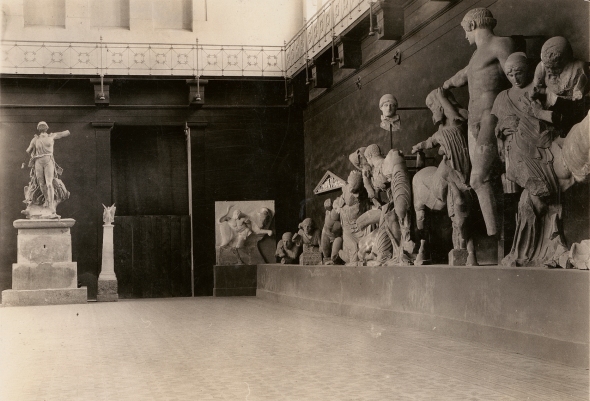
The old museum at Olympia, 1936-37. ASCSA Archives, Doreen Canaday Spitzer Photographic Collection.
A Mystery Solved
In the gardens of the American School, next to the great plane tree, there is a semicircular brick construction for sitting. A marble commemorative plaque embedded at one of its ends reads: “Edward Letchworth. ΜΝΗΜΗΣ ΧΑΡΙΝ.” I have been asked several times, most recently by the School’s Director Jenifer Neils: “Who is Letchworth and what was his relationship to the School?” He remained a mystery man since we couldn’t find his name in any of the long lists published in the two Histories of the American School. The mystery was finally solved while I was reading By One and One.
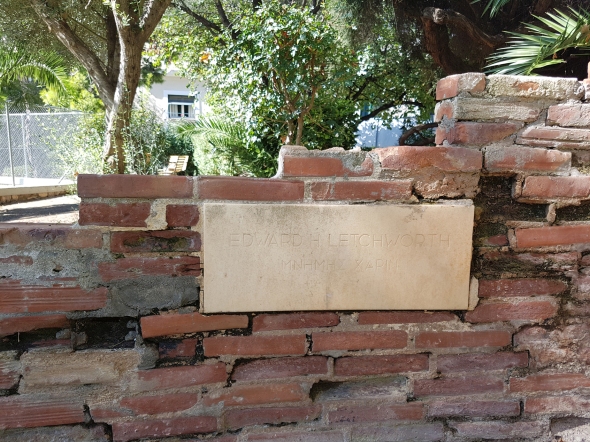
Commemorative plaque for Edward Letchworth in the lower garden of the American School. Photo: Natalia Vogeikoff-Brogan
Ted and Ruth Letchworth were long-time friends of the Canaday family; Doreen also implies that Ted and Mariam shared a special friendship: “The two of them had lovely times together… dinners followed by theater and on top of that, ‘dancing till two! Back to the hotel on air… Sodas in Grand Central Station before my train! Ultimo bacio!’ It was harmonious and gay and revivifying. Invariably she [Mariam] felt more kindly disposed toward the world and toward her husband after these meetings. She dog-eared the dates in her daybook. The memories sustained her spirits” (p. 222). There are also photos of Ted Letchworth in Doreen’s albums from Greece; he must have accompanied the Canadays when they came to see their daughter in the spring of 1937. Ted’s death in 1958 was devastating for Mariam. Was the plaque ordered by Mariam, or Doreen, and when? And why was it placed on that brick bench? Although the mystery of Mr. Letchworth’s identity has been solved, I am still missing pieces from this “puzzle.”
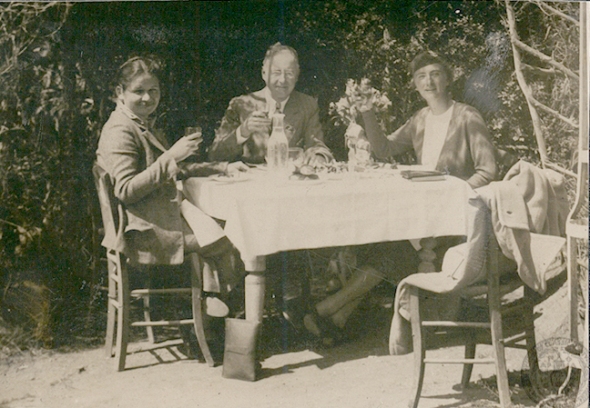
Margaret Hill, Ted Letchworth, and Doreen Canaday, 1937. ASCSA Archives, Doreen Canaday Spitzer.
A Legacy Begins
Doreen was forced to leave Greece at the end of 1938. She would have probably stayed longer had not WW II followed. She had started to study the Roman pottery from Corinth and was planning to continue her research in European museums. A year later, while in England for a month, she would resume her friendship with an old friend, Lyman Spitzer Jr., a young astrophysicist, who would have a distinguished career at Princeton University. By 1940 they were married. While Doreen was busy raising a family of four, her father became President of the Board in 1949. “His business acumen and financial influence, his contagious energy, perseverance, the chemistry of his personality—all contributed much to the School, particularly to the revival of interest in the Athenian Agora, which had naturally been in abeyance during the war years.” It’s no exaggeration to say that without Ward Canaday the reconstruction of the Stoa of Attalus in the Athenian Agora (1956) would not have happened. Two decades later, free from motherly and elderly obligations (Mariam died in 1974, Ward in 1976) Doreen would follow in her father’s steps and become an ASCSA Trustee in 1978 (but that’s another essay).
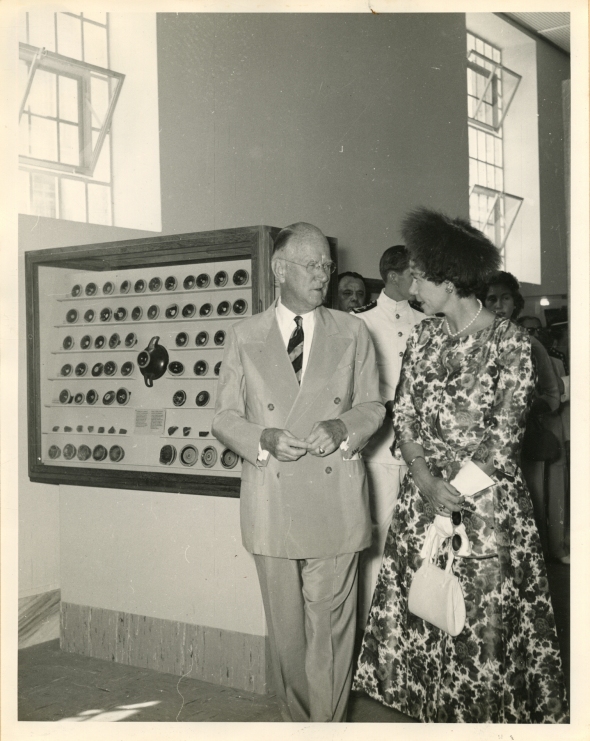
Ward Canaday and Queen Frederica at the inauguration of the Stoa of Attalus, 3 Sept. 1956. ASCSA Archives, Homer A. Thompson Papers.


[…] and talent in the Agora project. (On Ward Canaday and his daughter Doreen Canaday Spitzer, see “They returned… but stay I did”: Doreen Canaday’s Experience of Interwar Greece.) The other significant participant in the project was Homer A. Thompson, Director of the Agora […]